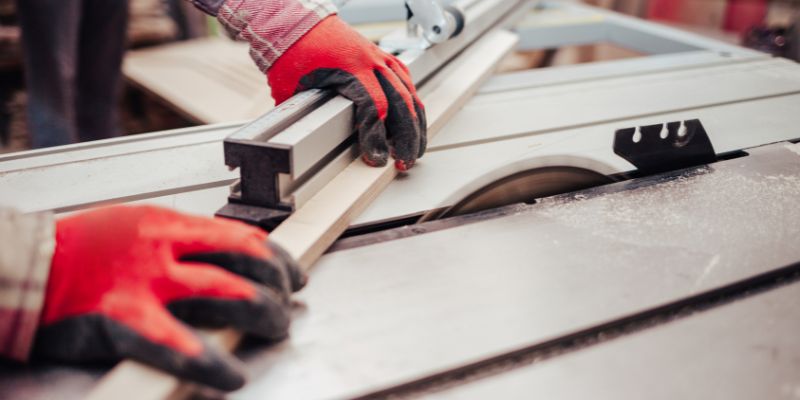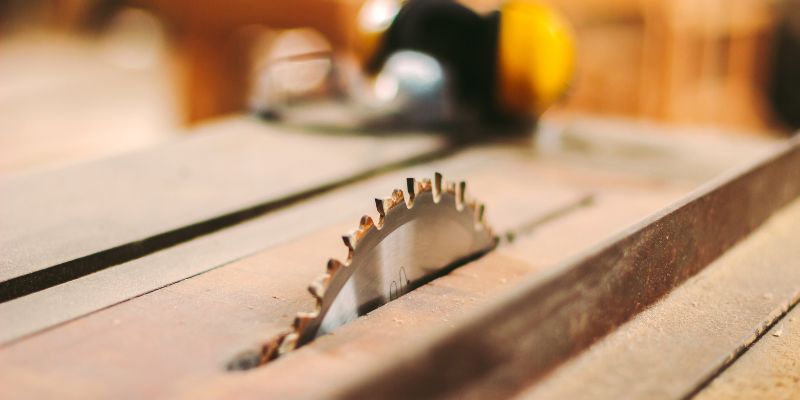To cut plywood with a table saw, begin by adjusting the saw blade height to the thickness of the plywood. Then, position the plywood on the table and carefully guide it through the saw blade, ensuring a smooth and steady motion to achieve a clean cut.
Cutting plywood with a table saw is a fundamental woodworking skill. Whether you’re a DIY enthusiast or a professional woodworker, knowing how to use a table saw to cut plywood is essential for many projects. In this guide, we’ll provide step-by-step instructions on how to safely and accurately cut plywood with a table saw.
By following these simple guidelines, you can achieve precise and professional-looking cuts, allowing you to tackle various woodworking projects with confidence and precision. Let’s dive into the details of how to effectively cut plywood with a table saw.
Plywood Cutting Basics
Cutting plywood with a table saw is a fundamental skill every woodworker should master. The inherent characteristics of plywood, such as its layered structure and varying core materials, present unique challenges when cutting. In this guide, we’ll cover the essentials of plywood cutting with a table saw, from understanding plywood types to essential safety precautions and preparing the table saw environment.
Understanding Plywood Types For Table Saw Cutting
Before diving into plywood cutting techniques, it’s crucial to familiarize yourself with the various types of plywood commonly used in woodwork. Different plywood types may require specific cutting methods and considerations on a table saw. Some commonly used types of plywood for cutting include:
| Plywood Type | Characteristics |
|---|---|
| Softwood Plywood | Typically made from softwood veneers such as pine or cedar. It’s comparatively easier to cut but may splinter at the edges if not properly handled. |
| Hardwood Plywood | Comprised of hardwood veneers like oak or maple, it provides a sturdy and durable surface for various woodworking projects. |
| Marine Plywood | Specially designed for moisture-resistance, making it ideal for outdoor applications. Cutting marine plywood requires attention to prevent delamination. |
Essential Safety Precautions
- Wear Protective Gear: Always wear safety goggles, hearing protection, and a dust mask to safeguard against potential hazards such as flying debris and sawdust.
- Use Push Sticks: Utilize push sticks or push blocks to maintain a safe distance from the saw blade while guiding the plywood through the cut.
- Keep Workspace Clear: Ensure the work area is free of clutter and obstructions to prevent accidents during the cutting process.
Preparing The Table Saw Environment
- Check Saw Blades: Verify the table saw blade is suitable for cutting plywood, ensuring it’s sharp and free from any damages.
- Adjust Blade Height: Set the blade height slightly higher than the thickness of the plywood to minimize tear-out and achieve clean cuts.
- Support the Plywood: Use additional support, such as roller stands or sawhorses, to provide stability and prevent the plywood from sagging during the cutting process.

Selecting The Right Blade
When it comes to cutting plywood with a table saw, selecting the right blade is crucial for achieving clean and precise cuts. The blade you choose will depend on the type of cut you want to achieve and the thickness of the plywood. Here’s a look at the key considerations for selecting the right blade.
Blade Types For Smooth Cuts
There are various blade types available for cutting plywood with a table saw, each designed for specific purposes. For smoother cuts, consider using a plywood blade or a fine-tooth finishing blade. These blades typically have more teeth, which results in a finer cut and reduces the likelihood of splintering the plywood surface.
Adjusting Blade Height And Angle
When cutting plywood, it’s important to adjust the table saw’s blade height and angle to achieve the desired results. For clean and accurate cuts, ensure that the blade is set at the right height relative to the thickness of the plywood. Additionally, adjusting the blade angle, if necessary, can help minimize tear-out and produce precise cuts.
Setting Up For Precision Cuts
When it comes to cutting plywood with a table saw, precision is key for achieving accurate and clean cuts. Setting up your table saw properly is essential for ensuring precise cuts and minimizing errors. Here are the crucial steps to follow for setting up your table saw for precision cuts.
Ensuring Accurate Measurements
Before you start cutting plywood, it’s essential to ensure that your measurements are accurate. Use a high-quality measuring tape or a reliable measuring tool to double-check the dimensions of your plywood sheet. Inaccurate measurements can lead to misaligned cuts and wasted material. Invest the time to measure twice and cut once for precision and efficiency.
Fence And Miter Gauge Usage
The fence and miter gauge play a critical role in guiding the plywood through the table saw for precise cuts. Ensure that the fence is parallel to the saw blade to maintain consistent and accurate cuts. Use the miter gauge to control the angle of the cut, and always make sure it is securely locked in place. Taking the time to check and adjust the alignment of these components will greatly contribute to the precision of your cuts.
Supporting Large Plywood Sheets
When working with large plywood sheets, proper support is vital for achieving precise and safe cuts. Use additional supports, such as sawhorses or extension tables, to provide adequate stability and prevent the plywood from sagging or binding during the cutting process. This extra support will help maintain the integrity of the plywood sheet and ensure that each cut is executed accurately.
How To Cut Plywood With A Table Saw : Mastering The Technique
When it comes to woodworking, cutting plywood with a table saw is a fundamental skill to master. Known for its versatility and efficiency, a table saw provides the precision and power needed for cutting plywood with ease. By mastering the technique, you can ensure clean and accurate cuts, allowing you to take your woodworking projects to the next level.
Step-by-step Cutting Guide
Here is a step-by-step guide to cutting plywood with a table saw to help you master the technique:
- Measure and mark: Begin by measuring the area on the plywood that needs to be cut. Use a straight edge and a pencil to mark the cut line.
- Set up the table saw: Adjust the table saw blade height to slightly higher than the thickness of the plywood. Ensure the rip fence is parallel to the blade and set at the desired width for the cut.
- Position the plywood: Place the plywood on the table saw with the marked cut line aligned with the blade.
- Turn on the saw: With protective gear on, turn on the table saw and steadily feed the plywood through the blade, keeping it flat against the table and the fence.
- Complete the cut: Once the cut is complete, switch off the saw and wait for the blade to come to a complete stop before removing the plywood.
Dealing With Common Plywood Cutting Issues
When cutting plywood with a table saw, several common issues can arise. Here’s how to address them:
- Tearout: To minimize tearout, use a sharp blade and score the cut line with a utility knife before making the actual cut.
- Chipboard or splintering: To prevent chipboard or splintering, place a sacrificial piece of material, such as masking tape, over the cut line before making the cut. This can help support the wood fibers and reduce splintering.
- Warped plywood: If the plywood is warped, make sure to support the entire sheet properly with roller stands or additional personnel to keep it flat and avoid dangerous kickbacks.
Achieving Clean Cuts Every Time
Whether you are a seasoned woodworker or just starting out, achieving clean cuts every time can be the ultimate goal when using a table saw to cut plywood. The smoothness and precision of your plywood cuts can significantly impact the overall quality of your woodworking projects. To ensure flawless results, it’s essential to explore effective techniques for reducing splintering and utilizing jigs and push sticks for better control.
Techniques For Reducing Splintering
When cutting plywood with a table saw, splintering can be a common issue that compromises the quality of the cuts. To minimize splintering and achieve cleaner cuts, consider the following techniques:
- Utilize a sharp blade: A sharp blade is crucial for clean cuts. Ensure your table saw blade is sharp and suitable for cutting plywood to prevent tearing and splintering.
- Score the cut line: Before making the actual cut, scoring the cut line with a utility knife can help reduce splintering along the edges of the plywood.
- Use masking tape: Applying masking tape over the cut line can provide additional support and minimize splintering, especially on the bottom side of the plywood.
Jigs And Push Sticks For Control
Enhanced control is essential for achieving clean cuts when using a table saw. Here are some effective ways to improve control during plywood cuts:
- Custom jigs: Creating custom jigs specifically designed for cutting plywood can ensure precise and consistent cuts, minimizing the risk of splintering and enhancing overall control.
- Proper push stick usage: Utilizing push sticks designed for plywood cutting helps maintain steady pressure and control, reducing the chances of splintering and enhancing the safety of the cutting process.
By implementing these techniques and utilizing jigs and push sticks for control, you can elevate your plywood cutting experience and consistently achieve clean, professional-looking cuts with your table saw.
Beyond The Basic Straight Cut
When it comes to working with a table saw, cutting plywood beyond the basic straight cut opens up a world of possibilities for creating custom pieces and intricate designs. Whether it’s ripping along the grain or crosscutting across it, or perhaps creating dadoes and rabbets, mastering these techniques can take your woodworking projects to the next level.
Techniques For Ripping And Crosscutting
Ripping and crosscutting are essential techniques for making precise cuts on plywood using a table saw. Here are some key points to keep in mind:
- Ensure the table saw blade is properly aligned and at the appropriate height for the material.
- Use a sharp, high-quality blade designed for clean cuts to reduce splintering.
- For ripping, guide the plywood against the rip fence, keeping the material firmly pressed against the table to avoid kickback.
- When crosscutting, using a miter gauge or a crosscut sled can help achieve accurate 90-degree cuts.
Creating Dadoes And Rabbets With A Table Saw
Utilizing a table saw to create dadoes and rabbets adds versatility to your woodworking projects. Here’s how to tackle these tasks effectively:
- Adjust the table saw blade to the desired depth for the dado or rabbet cut.
- Using a sacrificial fence or a dado stack, carefully guide the plywood through the cut, maintaining steady pressure and control.
- For rabbet cuts, consider using a rabbeting blade or a dado blade set for precise and clean results.

Frequently Asked Questions On How To Cut Plywood With A Table Saw
How Do I Prepare Plywood For Cutting With A Table Saw?
To prepare plywood for cutting, ensure it’s firmly supported and mark the cutting lines clearly. Check the blade alignment and adjust the saw’s settings for the thickness of the plywood. Use safety equipment such as goggles and ear protection before starting the cutting process.
What Type Of Table Saw Blade Is Best For Cutting Plywood?
For cutting plywood, a blade with a high tooth count and a negative hook angle is preferable. A triple-chip grind or a combination blade works well for clean and chip-free cuts in plywood. Ensure the blade is sharp and appropriately sized for the table saw.
What Are The Safety Precautions When Cutting Plywood With A Table Saw?
When using a table saw to cut plywood, it’s crucial to wear safety gear like eye protection, ear defenders, and a dust mask. Keep the work area clean and free of obstacles. Use push sticks or featherboards to guide the plywood and maintain a safe distance from the blade.
Conclusion
Cutting plywood with a table saw requires proper technique and safety measures. By following the step-by-step guide and using the right tools, you can achieve accurate and clean cuts. Practice makes perfect, so don’t be discouraged if it takes time to master.
Keep safety in mind and enjoy woodworking!


